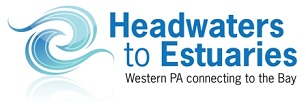
OPEN TO THE PUBLIC
NOAA Watershed Institute
HEADWATERS TO ESTUARIES
Enhancing Meaningful Watershed Educational Experiences with Immersive Technology
Saint Francis University has partnered with teachers and students in Bedford Area, Chestnut Ridge, Harmony Area, and Hollidaysburg Area school districts to provide meaningful watershed educational experiences (MWEEs) using stormwater best management practices (BMPs) as an organizing principle to engage students. Using technology, such as 360 degree cameras, the program will explore ways that watershed education can be immersive.

Explore this underwater photograph taken from video footage by institute participants!
Stormwater Runoff & the Chesapeake Bay
Stormwater runoff caries pollutants from the headwaters (where SFU and our partnering school districts are located) to the estuaries of the Chesapeake Bay. It also causes flooding and erosive loss of land and structures. Fortunately, scientists and engineers have developed highly effective ways of mitigating stormwater runoff known collectively as stormwater best management practices. In this project we use the stormwater BMP as an organizing principle to engage middle school students in a very visual and critically important environmental issue. Because stormwater is in everyone’s backyard, students will have ready access to hands-on field work near their school and because many stormwater BMPs are low-tech, students will be able to translate their study directly into action projects that help improve the local environment.
Primary Goals and Objectives:
Systemic MWEE Implementation is prioritized with the goals of
- conducting a Watershed Institute for teacher professional development
- developing immersive and interdisciplinary watershed curriculum units (MWEEs)
- providing academic year support for field work and MWEE delivery
- organizing culminating activities including:
- Student-led BMP design and implementation
- a regional Watershed Festival
Contact Us
Overall the project is anticipated to reach more than 1,100 students in grades 3-12 and 24 teachers. If you are interested in learning more about the project, please:
Email: scienceoutreach@francis.edu
Call: 814-472-2872
FAQs
-
What are MWEEs?
-
MWEE Promotional Video from Chesapeake Bay Program on Vimeo.
MWEE is an acronym for Meaningful Watershed Educational Experience
MWEEs are multi-stage, activities that include learning both outdoors and in the classroom, and aim to increase the environmental literacy of all participants.
For example: Learning the effect of water runoff in the Appalachian Mountains on marine life in the (may be approached from many angles: historical floods, statistics, testing of soil, topographic maps, pervious vs. impervious surfaces).
Learn more: https://www.noaa.gov/education/explainers/noaa-meaningful-watershed-educational-experience
-
What is B-WET?
The NOAA Bay Watershed and Training program is an environmental education program that promotes locally relevant, authentic experiential learning focused on K–12 audiences.
B-WET is a national program serving seven areas of the country: California, Chesapeake Bay, Great Lakes, Gulf of Mexico, Hawai'i, New England, and the Pacific Northwest.
Chesapeake Bay is our regional program
Learn more: https://www.noaa.gov/office-education/bwet
-
Who Can Participate?
This program is open to teachers (grade 3 and above), staff, administration – anyone who is interested in environmental literacy.
This program is interdisciplinary. It is not limited to just science teachers - all disciplines are welcome to attend.
This unique program is currently only available to Bedford Area, Chestnut Ridge, Hollidaysburg Area, and Harmony school districts (and once the B-WET program has worked with a school district, it cannot do so again with this type of grant)
-
360 Degree Video Examples
-
MWEE Promotional Video from Chesapeake Bay Program on Vimeo.
MWEE is an acronym for Meaningful Watershed Educational Experience
MWEEs are multi-stage, activities that include learning both outdoors and in the classroom, and aim to increase the environmental literacy of all participants.
For example: Learning the effect of water runoff in the Appalachian Mountains on marine life in the (may be approached from many angles: historical floods, statistics, testing of soil, topographic maps, pervious vs. impervious surfaces).
Learn more: https://www.noaa.gov/education/explainers/noaa-meaningful-watershed-educational-experience
The NOAA Bay Watershed and Training program is an environmental education program that promotes locally relevant, authentic experiential learning focused on K–12 audiences.
B-WET is a national program serving seven areas of the country: California, Chesapeake Bay, Great Lakes, Gulf of Mexico, Hawai'i, New England, and the Pacific Northwest.
Chesapeake Bay is our regional program
Learn more: https://www.noaa.gov/office-education/bwet
This program is open to teachers (grade 3 and above), staff, administration – anyone who is interested in environmental literacy.
This program is interdisciplinary. It is not limited to just science teachers - all disciplines are welcome to attend.
This unique program is currently only available to Bedford Area, Chestnut Ridge, Hollidaysburg Area, and Harmony school districts (and once the B-WET program has worked with a school district, it cannot do so again with this type of grant)








